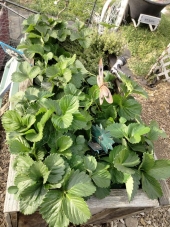posted 6 years ago
This year, I've started taking my Mom (87) to the Senior's Rec Centre (she needs to find more hobbies, and she hates gardening). Since I am still active and strong, I am likely to get "hit on" a fair amount.
Anyway, at the last Carpet Bowling, I was asked if I would like to take a rototiller to matted up strawberry patch. I didn't know much about strawberries, other than I know what they taste like and a few other points. I've read that they don't compete with weeds well, and yet there are lots of places in my 40+ year old fescue pasture, where there are extensive patches of strawberry. And I set up a patch of potatoe in wood chips this year, and the strawberries moved into there too.
With my fescue, I am trying very hard not to till. So, can I do the same with this strawberry problem?
Companion planting seems to be a bit of a problem for strawberries, as they don't seem to need help growing. They need help staying healthy, and they need help with population density (at least the June type does). Anyway, what appears to be a small companion list is: borage, chives, spinach, rhubarb, nasturtium and horseradish. Planting in a raised bed might be a good thing, it probably does result in an increased need for water. Nasturtium probably just needs to be close, to attract insects. Borage should be part of the bed, but probably doesn't need to be extensive. I would say that spinach and/or chives should be planted at about the same density as the strawberries (spinach+hives=strawberry), nominally to act as barriers to strawberry domination. While rhubarb should grow well with strawberry, that isn't my plan. I think horseradish is a good idea (deep roots, sort of like asparagus I gather (it gets planted with strawberries)), but how much and where? I would think that horseradish might help with the wilting problem.
To grow rhubarb in pots, you need big pots. Something like 2x2 feet and 2 foot tall. Not the kind of thing an elderly person who carpet bowls would probably want to move. It should be a lightweight soil (so probably a fair amount of volcanic foamed rock, and things like peat or coir in it. At the beginning of the season, you decide what section(s) of the bed are to be planted with new strawberry plants next year. You "chop and drop" those section(s), and set the rhubarb planters on top of those areas. Hence the pot will "shade out" some of the ground, and the rhubarb is going to partially shade out some of the nearby plants. When the rhubarb gets watered, the "excess" water from it will drop down into the strawberry bed. How far? Now that you have moved the rhubarb pots, it is time to plant new plants where the rhubarb pot was. In places which get very cold, a person may need to cover the rhubarb pots with insulation for the winter.
A few places have looked into "cover crops" to put strawberries into rotation. Broccoli seems to be a good fit for this. More recently, there has been work on mustard grown as a "green manure". Mustard is Sinapis hirta, Brassica juncea and Brassica nigra. They are specifically looking at the mild white and the brown mustard, not the black. There seem to be hybrids of the mild and the brown which produce more thioglycosides, which is the aspect of mustard which helps to reduce wilt problems via biofumigation. I would think that horseradish would contribute to this as well.
The chives can get haircuts during the season, and those cuttings can be used anywhere in the. Lots of articles talk about giving the strawberries hair cuts after harvest. Most say to not get the crown in the process.
There is mention that strawberries have shallow roots, and then everybody talks about tilling leaves and compost into the soil (without killing the roots). I gather what they are specifically talking about is tillage in the top 2 inches only.
There were some people who had success at letting chicken loose into a system vaguely like what I dreamt up, and chickens probably till he soil to the correct depth.

 2
2





















 1
1
























 2
2
















 1
1




 3
3




 4
4






 2
2




 4
4




















